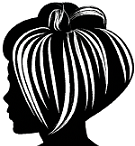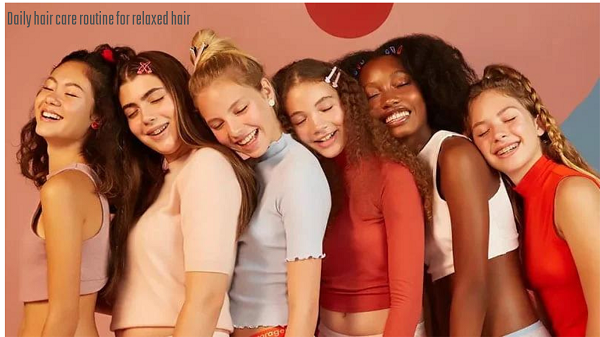Having relaxed hair requires a consistent and effective daily hair care routine to maintain its health and manageability. Relaxed hair refers to chemically treated hair that has undergone a process to straighten its natural texture. This article will guide you through the essential steps and products needed to keep your relaxed hair looking its best every day. By following a dedicated daily hair care routine, you can ensure that your relaxed hair remains nourished, moisturized, and protected from damage. Let’s dive into the details of establishing a successful daily hair care routine for relaxed hair.
Understanding relaxed hair
Relaxed hair is a popular treatment, especially among women. It is important to understand what this treatment is to help you care for and grow your hair. The process involves the use of a special type of lotion or cream that is called a relaxer.
Relaxers contain chemicals that break down the hair component to change its texture. It is commonly used by people with curls to “relax” the hair, resulting in straighter hair. The process can be drying, and hair needs to be cared for and nourished properly.
What is hair care, and why is it important?
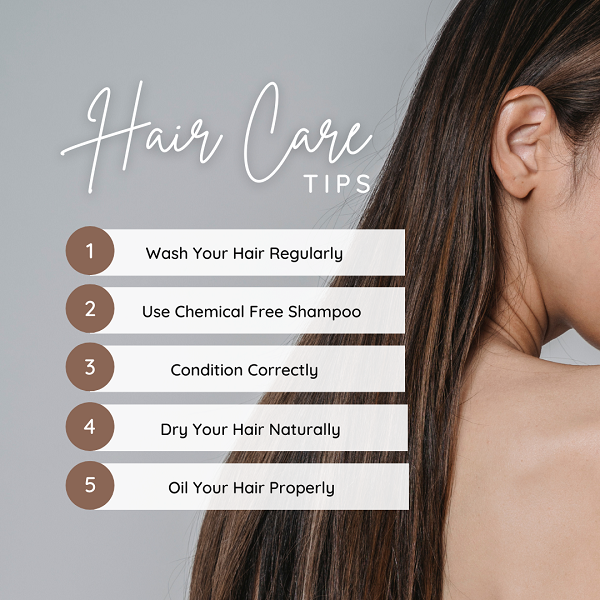
A hair care regimen is a regimen that everyone should follow to keep their hair healthy. Most hair damage is caused or worsened by a lack of proper hair care.
The main thing to understand is that not everyone’s hair is the same; This also applies to your hair care. A woman with curly hair should not stick to straight hair. Check out these hair care systems for all hair types.
Precautions and Tips for Maintaining Healthy Relaxed Hair
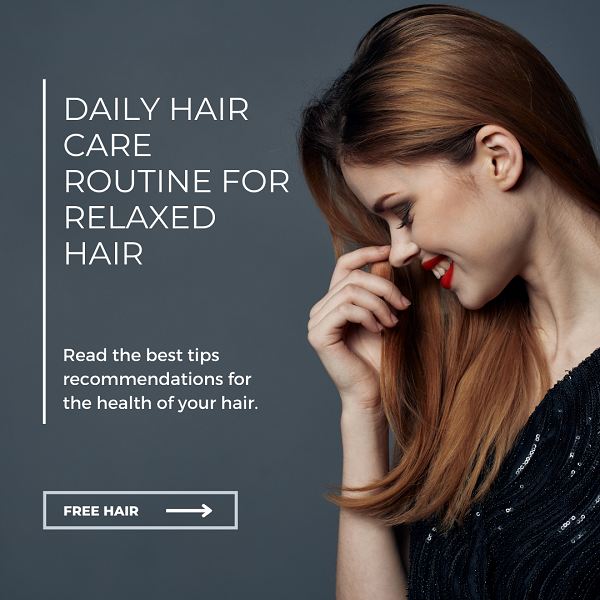
Taking proper precautions before going to bed and following a careful routine in the morning can significantly impact the health and appearance of your hair. This paragraph outlines essential tips and precautions to ensure your hair remains tangle-free, nourished, and protected from damage
Precautions before going to bed and getting up
Before going to bed, lightly massage your scalp, then make one or more very loose, lying braids or braids, or sleep with a scarf, preferably silk. Avoid cotton, which can make your hair brittle and cause so-called “breakage” hair loss, by absorbing much-needed moisture. Also, avoid synthetics or wool which make the scalp sweat and make the hair electric.
In the morning, is your hair still tangled? Are you in a hurry? Above all, do not try to untangle them in depth because you risk, in your haste, breaking more than one! Style your hair superficially, without pushing the teeth of the comb into your hair.
To thoroughly detangle your hair
It is a long action, which sometimes requires 20 to 30 minutes… Proceed section by section, holding a portion in one hand and the comb in the other. Always detangle from bottom to top, using a wide-toothed comb. Start at a height of 5 cm, from the tip, then gently move up towards the scalp. Pay attention to the curly–straightened junction! It must be treated even more gently, so as not to risk breaking it.
Massage to irrigate your roots
Place the pads of your fingers slightly apart, directly on the skin of the scalp, under your hair. Press firmly, then move back and forth or rotate. Then move your fingers and start again elsewhere.
Be careful, massaging does not mean rubbing: your fingers must not slip but remain firmly anchored on the area of the scalp where you placed them. The principle consists of sliding the skin along the skull and not the fingers along the skin. Allow about a minute to cover the entire head.
Choice of shampoo
This choice is important since, when washing your hair, you do not want to destroy the thin film of sebum that is supposed to protect it. Our advice: do not be lulled by inscriptions relating to plants reputed to be good for hair. These plants only have value in shampoo when they are sufficiently concentrated and the cleansing base is not too aggressive.
Washing

Gradually wet your head with lukewarm water, at around 30 to 35°, then distribute a small quantity of shampoo over the scalp and lengths.
Do not rub your head vigorously after applying your shampoo. As little aggressive as the cleansing base may be, it is still too aggressive for fragile roots, and the massage in this case would not add anything to the cleanliness of your hair. With your fingers flat, lightly rub your scalp, and need your hair gently, from the scalp to the ends, to avoid tangling. The operation should take 1 to 3 minutes, depending on the abundance of hair.
Important: Gradually pour the equivalent of one or two bowls of barely lukewarm water onto your hair, while continuing to knead it gently. This is to only very gradually eliminate the shampoo. Then rinse thoroughly. If your hair does not seem clean enough, you can repeat the operation once. Otherwise, it’s useless. For detangling, see above.
For the last rinse, add a teaspoon of apple vinegar to half a liter of spring water, to eliminate limescale, which is particularly harmful to frizzy hair.
Renew the proteins in your hair
Proteins are the basic component of hair. Special protein treatments replenish proteins in hair and build strength. They differ from conditioners that are infused with protein.
Different protein treatment products are available and may vary in ingredients, such as shea butter, yogurt, manuka honey, and essential oils. You can find the product that best suits your hair. Always follow label directions.
You can also try homemade protein treatments. These can target and nourish the exterior of the hair. How often you should do a protein treatment depends on the condition of your hair, it can be done once every four or six weeks.
Pay attention to your diet

Drink plenty of water, it’s a source of hydration for your scalp and hair. Include healthy, protein-rich foods in your diet to help your body produce keratin, which is essential for hair structure. Exercise regularly.
If maintaining a healthy diet is difficult, supplements such as vitamin B complex and folic acid are great for hair health too. Hair vitamins are also available to promote healthy hair growth.
Trim split ends
Trimming the ends can be counterintuitive, especially if you’re growing out your relaxed hair.
How does size help? Relaxed hair can be prone to split ends. It is important to remove damaged ends because they suppress hair growth.
Split ends can travel up the hair shaft and can lead to further damage to the hair. Cutting helps keep hair healthy as it grows.
Why is my relaxed hair not growing?

Here are the reasons why your relaxed hair isn’t growing:
- You do not care for or treat your hair intensively and deny it nutrients and moisture to maintain its length
- You over-manipulate your hair through heat styling, over-styling, or using high-voltage hairstyles
- You relax too soon, without enough new growth, and over-stress your hair
- You stretch your relaxer too far, and you end up with more hair breakage due to too much hair structure on your head
- Your scalp is dirty or inflamed, leading to clogged pores
- You suffer from hormonal imbalances or alopecia, which leads to hair loss and lack of hair growth
- You perform too many chemical processes on your hair, such as coloring or bleaching.
How long should I wait before reapplying relaxer if I’m growing hair?
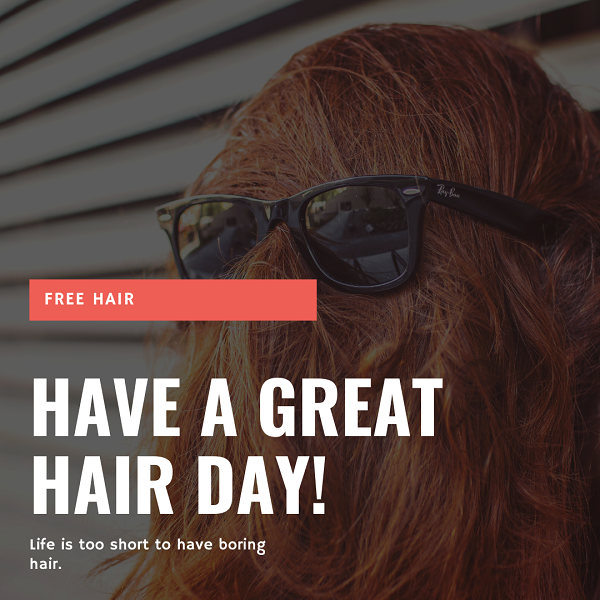
You should wait at least eight weeks before relaxing your hair again. You need enough new growth to relax to avoid over-processing already relaxed hair. On average, hair grows half an inch every four weeks. Those whose hair grows quickly can achieve growth of up to 10 cm in eight weeks.
You can choose whether you want to wait just eight weeks or extend your relaxation exercises. Some people stretch their relaxers for up to six months. However, if you wait too long between straighteners, your hair is more likely to break and look dull. Find out what schedule works best for your hair to ensure length is maintained and avoid over-processing or breakage.
So how to grow long, healthy, relaxed hair?
The key to growing long, healthy, relaxed hair is maintaining good overall health, caring for the scalp, and preventing hair breakage. You want to focus on:
- Eat nutrient- and protein-rich foods to nourish your hair from the inside out
- Protect your hair and avoid too many manipulations
- Thoroughly condition your hair often
- Maintaining a protein-moisture balance to avoid breakage
- Keep your scalp clean and hydrated
- Avoid overlapping with relaxers by allowing sufficient growth before retouching and protecting previously relaxed hair with conditioner, grease, or a balm.
Conclusion
In conclusion, establishing a daily hair care routine for relaxed hair is essential for maintaining its health, and manageability, and promoting natural hair growth. By following a few key steps, such as moisturizing regularly, avoiding over-processing, trimming as needed, protecting your hair at night, maintaining a healthy diet, and minimizing heat styling, you can ensure that your relaxed hair remains nourished, strong, and vibrant. Consistency and patience are key when it comes to caring for relaxed hair and achieving natural hair growth. With a dedicated daily hair care routine tailored to the needs of your relaxed hair, you can enjoy beautiful, healthy locks that thrive and grow naturally.
